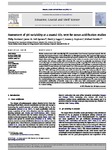Assessment of pH variability at a coastal CO2 vent for ocean acidification studies
| dc.contributor.author | Kerrison, P | |
| dc.contributor.author | Hall-Spencer, Jason | |
| dc.contributor.author | Suggett, DJ | |
| dc.contributor.author | Hepburn, LJ | |
| dc.contributor.author | Steinke, M | |
| dc.date.accessioned | 2013-02-20T08:58:48Z | |
| dc.date.accessioned | 2013-04-25T14:57:13Z | |
| dc.date.available | 2013-02-20T08:58:48Z | |
| dc.date.available | 2013-04-25T14:57:13Z | |
| dc.date.issued | 2011-08-20 | |
| dc.identifier.issn | 0272-7714 | |
| dc.identifier.issn | 1096-0015 | |
| dc.identifier.uri | http://hdl.handle.net/10026.1/1462 | |
| dc.description | The version on PEARL: Corrected proofs are Articles in Press that contain the authors' corrections. Final citation details, e.g., volume/issue number, publication year and page numbers, still need to be added and the text might change before final publication. Although corrected proofs do not have all bibliographic details available yet, they can already be cited using the year of online publication and the DOI , as follows: author(s), article title, journal (year), DOI | |
| dc.description.abstract |
Marine environments with naturally high CO2 concentrations have become important research sites for studying the impacts of future ocean acidification on biological processes. We conducted high temporal resolution pH and temperature measurements in and around a shallow (2.5-3m) CO2 vent site off Ischia, Italy in May and June 2008. Loggers were deployed at five stations to monitor water at both the surface and benthos. Our reference station, 500m from the CO2 vent, had no noticeable vent influence. It had a naturally high and stable benthic pH (mean 8.16, inter-quartile range (IQ): 8.14-8.18) fluctuating with diel periodicity, presumably driven by community photosynthesis and respiration. A principal component analysis (PCA) revealed that the pH of this station was well constrained by meteorological parameters. In contrast, a station positioned within the vent zone, had a low and very variable benthic mean pH of 7.11 (IQ: 6.91-7.62) with large pH fluctuations not well constrained by a PCA. Any stations positioned within 20m of the main vent zone had lowered pH, but suffered from abnormally large pH fluctuations making them unsuitable representatives to predict future changes to a shallow coastal environment. Between these extremes, we identified a benthic area with a lower pH of 7.84 (IQ: 7.83-7.88) that retained many of the characteristics of the reference station such as a natural diel pH periodicity and low variability. Our results indicate that a range of pH environments maybe commonplace near CO2 vents due to their characteristic acidification of benthic water over a wide area. Such environments could become invaluable natural laboratories for ocean acidification research, closely mimicking future CO2 conditions in a natural setting. © 2011 Elsevier Ltd. | |
| dc.format.extent | 129-137 | |
| dc.language | en | |
| dc.language.iso | en | |
| dc.publisher | Elsevier BV | |
| dc.relation.replaces | http://hdl.handle.net/10026.1/1328 | |
| dc.relation.replaces | 10026.1/1328 | |
| dc.subject | ocean acidification | |
| dc.subject | carbon dioxide | |
| dc.subject | volcanic vents | |
| dc.subject | pH | |
| dc.subject | coastal zone | |
| dc.subject | Italy, Ischia, Bay of Cartaromana (40 degrees 043.84 ' N 013 degrees 57.08 ' E) | |
| dc.title | Assessment of pH variability at a coastal CO2 vent for ocean acidification studies | |
| dc.type | journal-article | |
| dc.type | Article | |
| plymouth.author-url | https://www.webofscience.com/api/gateway?GWVersion=2&SrcApp=PARTNER_APP&SrcAuth=LinksAMR&KeyUT=WOS:000294978700002&DestLinkType=FullRecord&DestApp=ALL_WOS&UsrCustomerID=11bb513d99f797142bcfeffcc58ea008 | |
| plymouth.issue | 2 | |
| plymouth.volume | 94 | |
| plymouth.publication-status | Published | |
| plymouth.journal | ESTUARINE COASTAL AND SHELF SCIENCE | |
| dc.identifier.doi | 10.1016/j.ecss.2011.05.025 | |
| plymouth.organisational-group | /Plymouth | |
| plymouth.organisational-group | /Plymouth/Faculty of Science and Engineering | |
| plymouth.organisational-group | /Plymouth/Faculty of Science and Engineering/School of Biological and Marine Sciences | |
| plymouth.organisational-group | /Plymouth/PRIMaRE Publications | |
| plymouth.organisational-group | /Plymouth/REF 2021 Researchers by UoA | |
| plymouth.organisational-group | /Plymouth/REF 2021 Researchers by UoA/UoA07 Earth Systems and Environmental Sciences | |
| plymouth.organisational-group | /Plymouth/Research Groups | |
| plymouth.organisational-group | /Plymouth/Research Groups/Marine Institute | |
| plymouth.organisational-group | /Plymouth/Users by role | |
| plymouth.organisational-group | /Plymouth/Users by role/Academics | |
| dc.identifier.eissn | 1096-0015 | |
| dc.rights.embargoperiod | Not known | |
| rioxxterms.versionofrecord | 10.1016/j.ecss.2011.05.025 | |
| rioxxterms.licenseref.uri | http://www.rioxx.net/licenses/all-rights-reserved | |
| rioxxterms.type | Journal Article/Review |


